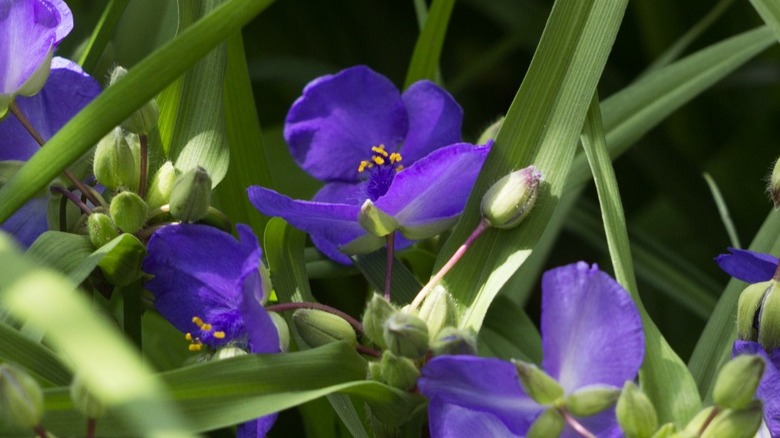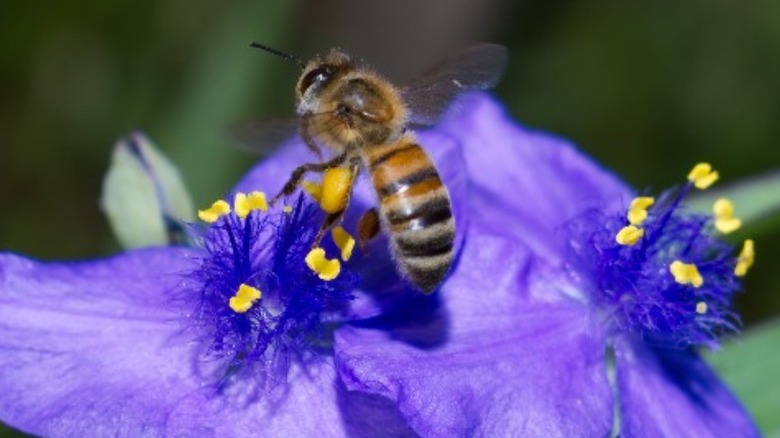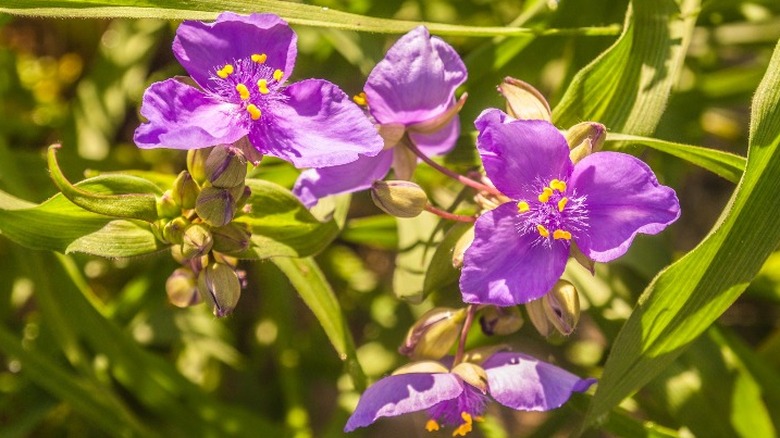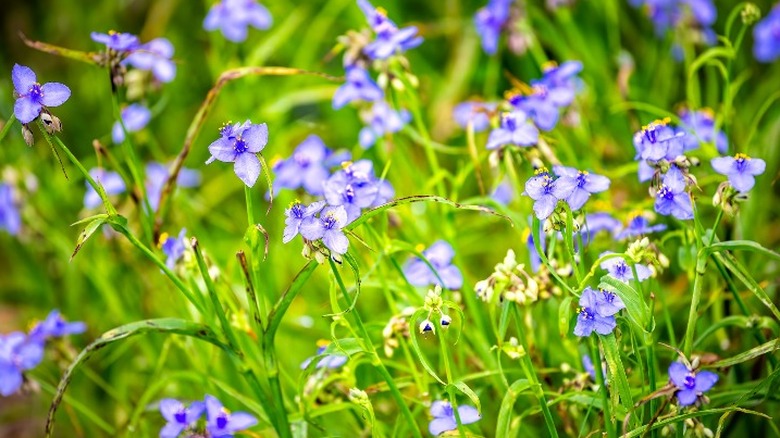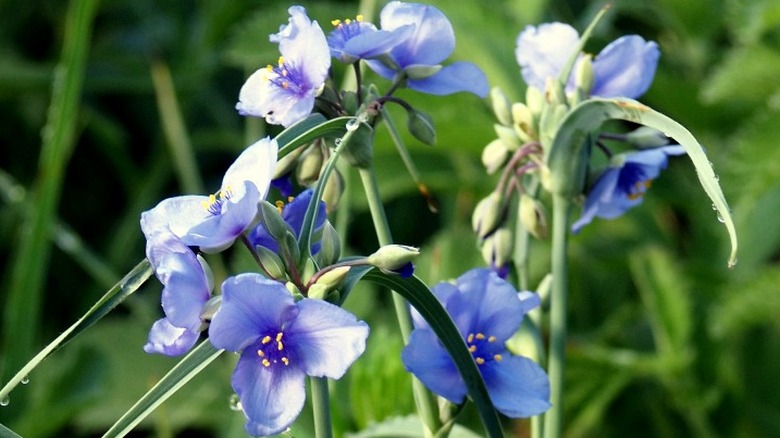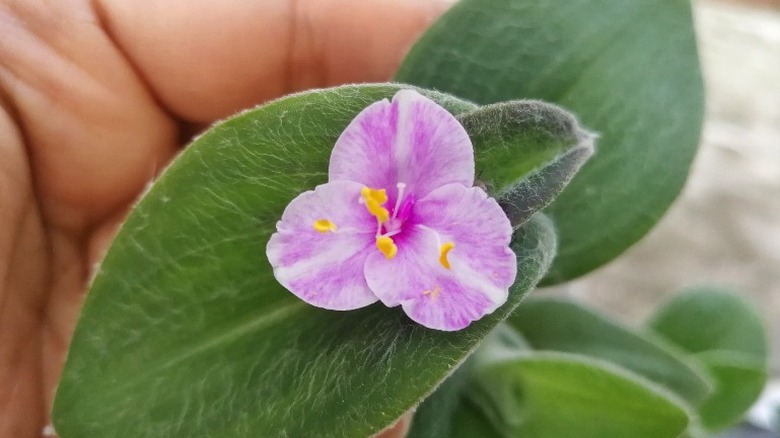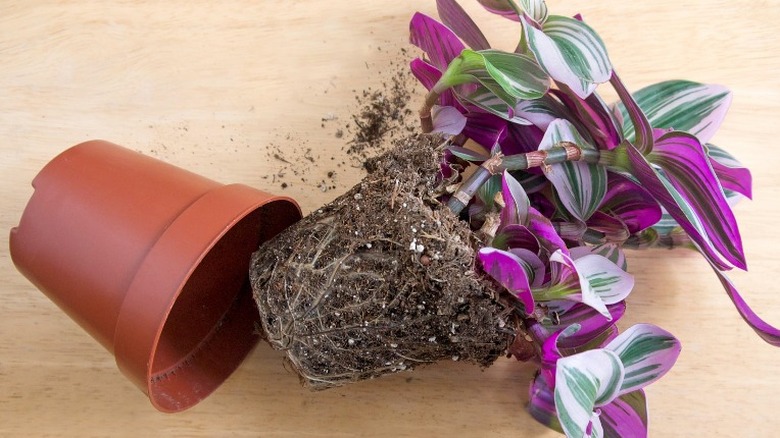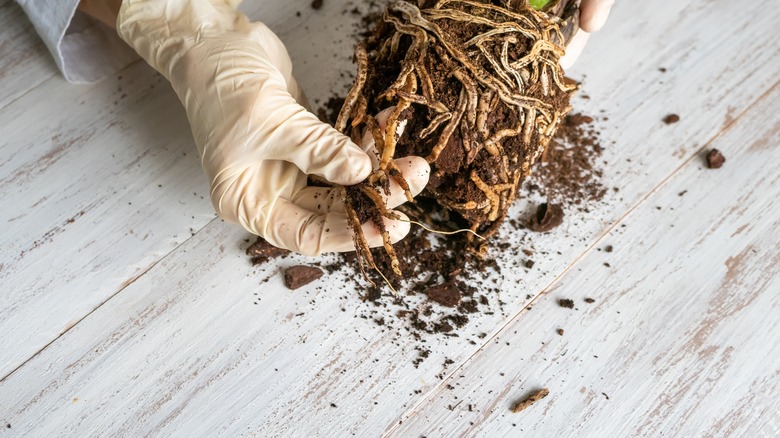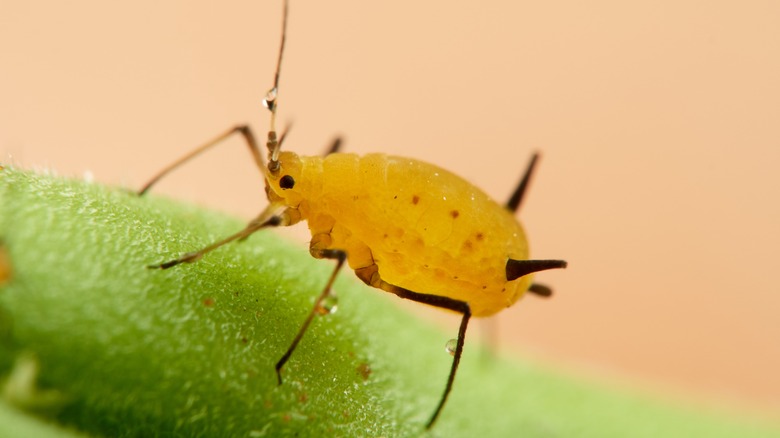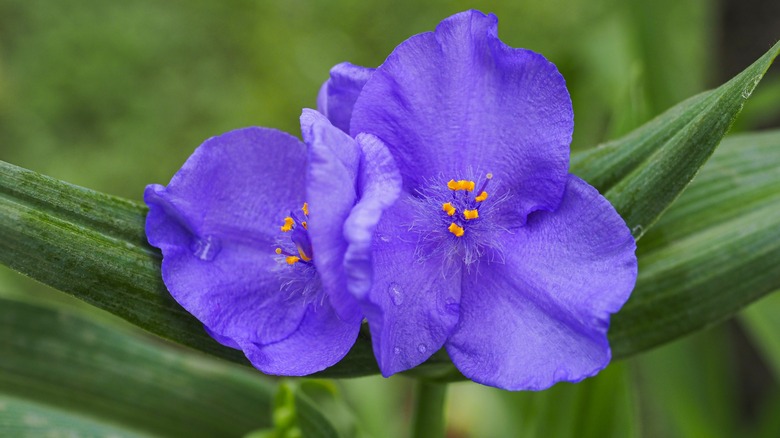Spiderwort: Everything You Need To Know Before Planting
Spiderwort or Tradescantia is a grassy perennial plant native to the Americas. Its colorful, three-petal flowers first emerge in early spring, and range in color from deep blue to bright pink, and less commonly, white. The blooms survive just a single day, opening in the early morning but fading by the heat of the afternoon. The Gardening Channel reassures, however, that the long blooming season stretches into the summer months and ensures plenty of time to enjoy the ephemeral blossoms. This, in addition to its hardiness and ease of care, makes spiderwort a popular plant among gardeners of any skill level.
Spiderwort is named rather literally. According to Missouri Botanical Garden, spiderwort stems release a syrupy fluid when cut. Once it solidifies, the substance becomes smooth and stringy, similar to a spider's web. Before blooming, spiderwort buds resemble small clusters of spiders or their egg sacs hanging on a web. The plant's long, thin, leggy leaves are also reminiscent of a spider's own long, thin legs. Whichever the true source, it's clear that the plant is aptly named. Like it's namesake, spiderwort can adapt and thrive in a wide variety of natural settings. Keep reading below for everything you need to know before adding spiderwort to your own garden.
How to use spiderwort in garden
Spiderwort thrive in partial shade, making them a great option to plant below trees or other areas of your garden that receive less than three to six hours of sunlight per day. Certain spiderwort varieties can grow up to 3 feet in height, meaning that its bright blooms will stand out in even the shadier, less visible sections of your garden. A great way to incorporate spiderwort into your garden is to plant it behind shorter species to create a full, balanced garden bed arrangement.
Spiderwort is a favorite among pollinators that fertilize the plants to help them reproduce. The Lady Bird Johnson Wildflower Center emphasizes that it is a great choice for any gardener hoping to attract bees, birds, and butterflies and enrich the local ecosystem. To best attract pollinators, plant spiderwort in clumps, similar to how they grow naturally in the wild. Spiderwort are perennial plants, meaning that unlike annuals, they will grow back and spread each year after planting. Spiderwort is especially well-suited for bare garden beds where it will have plenty of room to grow, as the plants spread quickly and can overtake the area they inhabit if they are not property maintained. Fortunately, they are relatively easy to divide and transplant to other areas of your garden.
How to grow and propagate spiderwort
Spiderwort grows as a wildflower in areas where it is native, but it is also a popular garden bed plant. The Gardening Channel instructs gardeners to plant outdoor seeds in the fall. Before sowing, prepare your garden bed by adding compost to the soil. Once the compost has been mixed to a depth of 8 inches, rake the soil so it's even. Plant seeds about 1/8 inch deep so they are lightly covered, and about 8 to 12 inches apart. It is important that the plants have enough space between them for air to circulate to avoid disease such as powdery mildew.
Gardening Know How explains that spiderwort can be propagated by dividing existing plants, or by stem cuttings. To grow by stem cuttings, plant in the late summer or early fall with enough time for the spiderwort to grow roots before the winter. Propagating by dividing existing spiderwort plants takes a bit more work, but Homestead Gardens breaks it down. Start by digging out the existing plant. Use a sharp knife to cut through the root ball and divide into two to three clumps. Space the divided plants 8 to 12 inches apart, and plant deep enough to cover the entire root structure. Plants can be divided in either the spring or fall, but it should be done every three years or so to avoid overcrowding.
How to care for spiderwort
Spiderwort is a well-rounded perennial, and some of its best characteristics are its resilience and ease of care. Spiderwort can survive in a variety of soil conditions (it's even drought resistant!) but does best when grown in moist, well-draining soil with a high humus content and a slightly acidic pH of 5.0 to 6.0. The Spruce goes on to explain that Spiderwort should be watered every two to three days, and even more frequently in the summer months.
Spiderwort can also withstand a wide range of sunlight conditions, though it prefers partial shade. The amount of sunlight can have an impact on the plant's performance, and determine the level of necessary care. Greater exposure to sunlight will help the plant produce more flowers, but plants in full sun (six or more hours) require more frequent watering. Spiderwort will grow well as long as it has enough sunlight and water, but these factors are important to keep in mind as you are planning your garden.
Spiderwort requires very little in terms of fertilizing, and is able to sustain itself after just a couple applications at the start of its growing period in early spring. The end of its blooming period is actually when Spiderwort requires the most care. Unfortunately, spiderwort wilts quickly after it finishes flowering, and if left unchecked it can grow leggy and unappealing. This can be remedied by pruning mid-season, which also benefits the plant by preventing self-seeding and encouraging healthier, late-season blooms.
Varieties of spiderwort
The Lady Bird Johnson Wildflower Center clarifies that the name spiderwort refers to over 70 known species in the genus Tradescantia, named for John Tradescant who worked as a gardener for King Charles I in the 17th century. Spiderwort is native to the Americas and can be found growing as far north as Canada and as far south as Argentina. All species share similar characteristics, though mature plants range in size from 6 inches to 3 feet tall.
The most commonly grown species is the Virginia Spiderwort (Tradescantia virginiana). According to The Spruce, other varieties were developed by plant breeders to produce specific aesthetic characteristics, such as leaf shape and bloom color. Some other species of spiderwort include:
- Zigzag Spiderwort (T. subaspera) is named for its zig-zag stem, which can grow up to 3 feet in height.
- Ohio Spiderwort or Bluejacket (T. ohiensis), is found throughout the Midwest, known for the range of colorful flowers and whitish bloom on the hairless stem.
- Hairy-stemmed Spiderwort (T. hirsuticaulis), grows primarily in the southern United States and can be recognized by its light blue flowers and leaves covered with small hairs.
- Tharp's Spiderwort or Dwarf Spiderwort (T. tharpii), is one of the smallest varieties of spiderwort, its bright green leaves growing close to the ground and its stem extending just 6 inches in height.
Is spiderwort toxic?
Spiderwort has low poison characteristics and poses little danger to humans and pets. However, its leaves and sap can cause skin irritations such as redness, itching, and contact dermatitis in sensitive individuals who are prone to skin reactions.
According to Edible Wild Food, Spiderwort has been traditionally used by First Nations tribes in a variety of culinary and medicinal capacities. Spiderwort seeds can be cooked and pulverized into a powder, rendering them safe to eat though rather acrid. The vibrant flowers can be eaten fresh, in a salad for example.
While gardening, there is always a chance you may encounter unfamiliar plants and insects that range in toxicity and could cause harm. Thankfully, there are several measures you can take to ensure your safety. It is always a good idea to wear gloves to protect your hands while gardening. It is also helpful to own a plant identification guide, particularly one specific to the region in which you live. If you are unsure of the type of plant you've encountered, inquire with neighbors and friends who may have more experience with local flora and fauna. Most importantly, if you have an adverse reaction, stop gardening and seek medical assistance immediately.
How to repot spiderwort
If you decide to grow spiderwort in a container rather than a garden bed, there are specific ways to maximize growth and ensure your plant stays healthy. According to Garden Beast, spiderwort plants grown in containers will have slightly different characteristics than plants grown in a garden bed, or in the wild. When grown in a container, spiderwort plants produce fewer leaves, darker flowers, and have a longer blooming period. They are also less tolerant of heat than their in-ground counterparts, as they are surrounded by less soil to retain moisture. Thus, potted spiderworts should be placed in shadier spots for best results.
The ideal time to repot your spiderwort is early spring, or late fall. Repotting the plant during the winter months when it is in its dormancy period can shock the plant and risk harming it. Spiderwort do not become root bound, and prefer to live in smaller pots. To repot your spiderwort, select a container that gives the plant an inch or two of room. Gardening Know How recommends planting with a well-draining container mix — either a soilless potting mix or loam-based compost. Gently spread out the roots by hand and remove excess soil. Place new soil in the base of the container before setting the plant inside. Carefully add additional soil between the plant and the container walls until the roots are covered, and the plant rests securely in the pot. Give your plant some water and enjoy its colorful blooms.
Spiderwort diseases to watch for
Plants are no different from all living things and can catch damaging or fatal diseases due to various circumstances. Root rot is an issue well-known by most amateur and professional gardeners and occurs when plants are trapped in soil that is too moist. This can be due to dirt having poor drainage, the gardeners themselves overwatering, or excessive rainstorms in the area. Too much water causes a mold to grow and rot the roots, turning them into a gooey substance that eventually kills the plant. You must remove all affected plants to prevent mold from spreading to others within reach.
Rust is another disease common in spiderwort. This fungal condition leaves brownish-red spots on greenery and can harm a plant's appearance and health. If you spot the first signs of rust early on, you can simply remove the affected leaves, which may solve the issue. However, there is no chemical treatment for eliminating this problem other than removing any sign of the fungus you see. Remember to disinfect any tools you use to prune your plants and to gather and clear the cut-off pieces to ensure the fungus is completely removed from the spiderwort's vicinity.
How to prevent spiderwort pests
Since spiderwort plants grow in USDA zones four through 12, they are susceptible to pests that also thrive in these regional climates. Although the winter keeps insect infestations at bay, the warmer temperatures in spring and summer can put your plant at risk. Aphids are fond of spiderwort leaves, and as they feed on them, they also spread disease. These insects will make your plant unsightly by causing the colorful leaves to shrivel and brown. They don't directly kill the plant but make it more vulnerable to other diseases. Spider mites are another insect to watch for on these grass-like herbs. These creatures feed on the plant just as aphids do, but do directly cause the leaves to die.
Don't give up too soon if you have either of these pests infesting your plant, for both issues are treatable. Spraying the infested plants with a hose will push the bugs off, but this is usually only a temporary solution. Use neem oil, insecticidal soaps, and horticultural oils according to their manufacturer's instructions to treat and prevent these bugs from returning. You can also apply a weak water and dish soap solution to both sides of your plant leaves, making it difficult for bugs to find perch and feed. Using this solution can be tedious, as you must re-coat the leaves every few days, meaning you should look for specialized products to prevent pest infestations long-term.
Best companion plants for spiderwort
Spiderwort is an excellent plant for gardeners of all skill levels. When pairing it with other plants in your garden, you simply need to choose plants that thrive in similar conditions; slightly acidic and well-draining soil, partial shade, and about 1 inch of water per week. Bleeding hearts and black-eyed Susans are two vibrant flowers that require similar nourishment and conditions to spiderwort. Common bonesets and foxgloves are also native to much of the Southeastern United States and the same USDA growing zones and make good companion plants for this species.
All four of these companion plants are deer-resistant, meaning they deter wildlife and aren't likely to be consumed by outdoor animals. Since spiderwort itself is also deer-resistant, you won't need to be too concerned with wildlife tearing up your garden. If you're a fan of spiderwort in general, you should also consider planting different varieties of this species. Many spiderworts vary from purple to green colors and have distinct patterns on their leaves, and you can create a dynamic landscape by pairing multiple varieties together.
